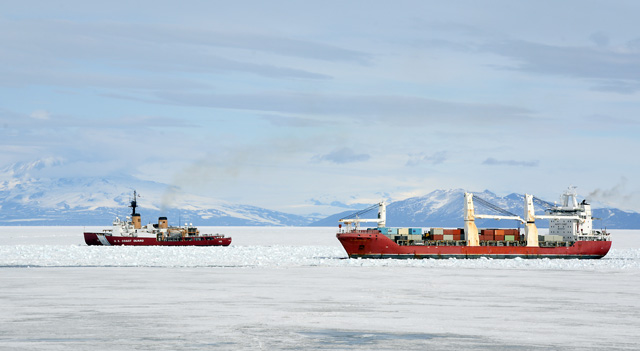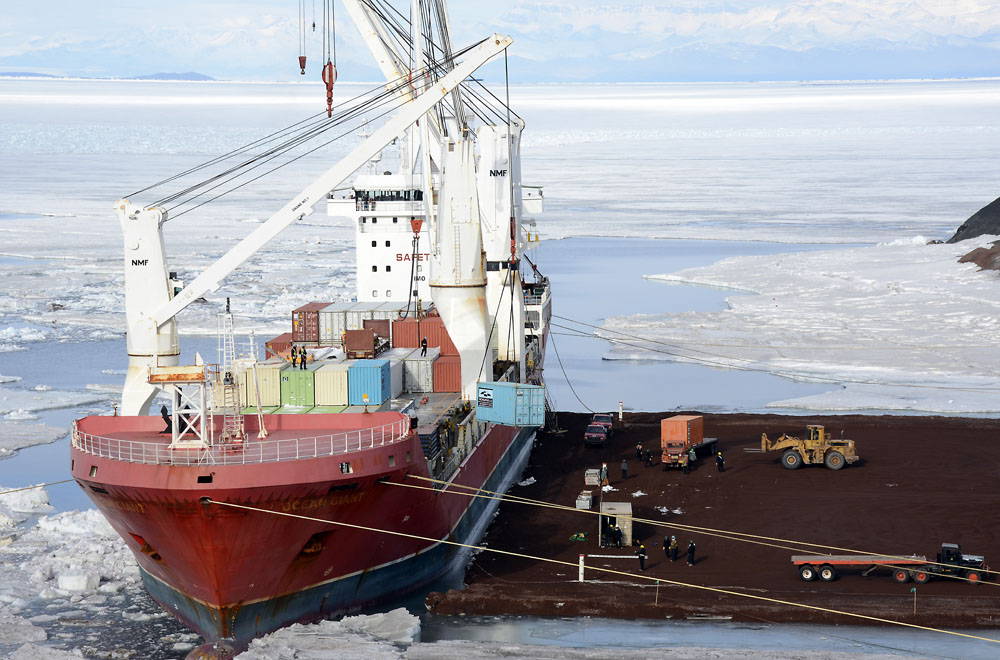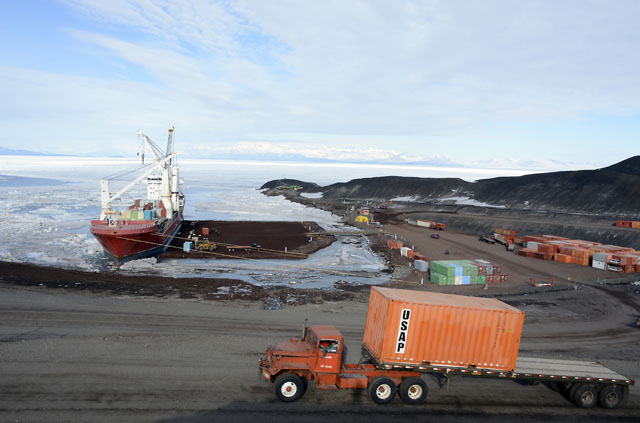Big loadCargo operations mark the beginning of the end to 2014-15 Antarctic field seasonPosted January 27, 2015
The operation is so big it's known simply as Vessel. 
Photo Credit: Peter Rejcek
The U.S. Coast Guard cutter POLAR STAR, left, escorts the MV OCEAN GIANT through the sea ice near McMurdo Station on Jan. 26.
The cargo vessel chartered by the Military Sealift Command to resupply two of the National Science Foundation's research stations in Antarctica seems up to the task based on name alone. The MV Ocean Giant, above, arrived at McMurdo Station on Monday, Jan. 26 (local time), with nearly seven million pounds of supplies. Its arrival marks the beginning of the end of the 2014-15 summer season for the U.S. Antarctic Program. It will take about a week to unload the 370 containers and 15 pieces of break-bulk cargo. The ship evolution, as it's known, includes reloading the 545-foot-long ship with an estimated 550 containers, including refrigeration units that will contain nearly 2,000 feet of ice cores drilled at Amundsen-Scott South Pole Station. The 24-hour operation involves many of the support personnel based at McMurdo Station who must process the cargo, which includes nearly 1.2 million pounds of food and beverages, along with almost 40,000 pounds of fresh foods loaded onto the ship from New Zealand. Members of the Navy Cargo Handling Battalion and New Zealand Defence Force arrived by air shortly before the Ocean Giant was scheduled to reach McMurdo to help with the cargo operation. The former work on the ship to move "the cans" – the sea containers – to and from the pier, which is made of ice that is about 15 feet thick and covered with a layer of dirt. The military personnel from New Zealand operate flatbed trucks to transport the milvans from the wharf area to McMurdo Station proper. A key part of the ship evolution involves the U.S. Coast Guard cutter Polar Star, a heavy icebreaker capable of breaking about six feet of ice at a continuous three knots. It can smash up to 21 feet of ice by ramming. The icebreaker is required to cut a swath in the sea ice around McMurdo to allow the cargo ship and other vessels access to the station. This year the edge of the sea ice was about 19 miles from the station. Next up is the MT Maersk Peary, a tanker carrying about five million gallons of fuel to replenish the tanks at both McMurdo Station and South Pole Station. The latter is resupplied by air and overland through a tractor train that pulls collapsible bladders. During the 2014-15 summer season, the South Pole Traverse delivered a record 317,000 gallons of fuel. Eight new traverse tractors are on this year's cargo vessel. The Maersk Peary is scheduled to arrive at the pier on Feb. 4. McMurdo winter operations are set to begin Feb. 28. Vessel operations on station can be observed via the (seasonal) McMurdo Pier Camera, available at the McMurdo Webcams page. |



For USAP Participants |
For The Public |
For Researchers and EducatorsContact UsU.S. National Science FoundationOffice of Polar Programs Geosciences Directorate 2415 Eisenhower Avenue, Suite W7100 Alexandria, VA 22314 Sign up for the NSF Office of Polar Programs newsletter and events. Feedback Form |




